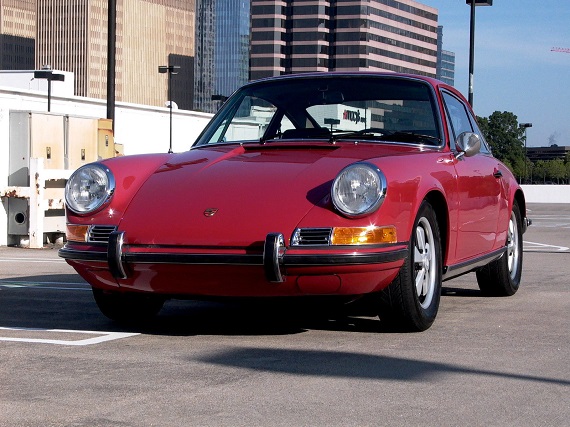The 911E is a model that I particularly like. It won’t have the frenzied investment potential of a 911S, but it makes for a good investment while also possessing a few advantages over the 911T. All 911 models from these years are worthwhile in their own right, though there is a shifting balance between driver and investor and finding the right car is not always easy. The example we see here comes in the very period-correct color of Sepia Brown: a one-owner 1971 Porsche 911E, located in California, with a claimed 16,000 miles on it. Sepia Brown would not qualify as my favorite shade on a 911, but brown on brown does tend to fit the period and still serves as a departure from many of the standard colors we see today.
Tag: 911E
There is something about the early targas that I really find aesthetically pleasing, or at least more so than the later versions. The contrast of the chrome and the exterior paint. The way the original body design naturally curves on each end prior to the integration of the impact bumpers. The total design just works to form a very appealing package. The newly designed 991 Targa appears to reflect this design a little better than some previous models, though obviously in a much more technological manner. And that gets at the heart of why these early cars are great. Simplicity and a connection that technology struggles to replicate. The Targa has had a rough life as a 911 as it has always been less appreciated relative to its Coupe and Cabriolet counterparts. In some ways I understand that and then I come across a car like this and it makes no sense. Here we have a Tangerine 1969 Porsche 911E Targa, located in Santa Barbara, with 31,443 miles on it. While I’d like to see something to verify the low mileage of this car, everything appears in remarkable shape.
CLICK FOR DETAILS: 1969 Porsche 911E Targa on eBay
1 CommentIt’s nice to see another of the more interesting colors available for the 911. Bahama Yellow even brings with it a touch of subtlety relative to some of the other yellows available, which really shows in the hilly vineyard scenery of the pictures here. 1969 is also important for the 911 as it was the year Porsche extended the wheelbase by 57 mm across the 911 range so as to provide more balanced dynamics. The 911E was the mid-range model available, between the entry-level 911T and sportier 911S. These were distinguished from the T by having upgraded interior as well as Bosch fuel injection rather than the Weber carbs of the T. In all, the E had more power, better dynamics, and a more luxurious interior than the T and on the current market they strike a nice balance that doesn’t reach the monetary heights necessary to purchase the extremely desirable S.
CLICK FOR DETAILS: 1969 Porsche 911E Coupe on eBay
Comments closedThe 911E is a particular favorite of mine for its balance between the entry-level 911T and the top-of-the-line 911S. Don’t get me wrong, I don’t mean to denigrate the 911S, but prices for almost any example are through the roof and you may even reach six figures for cars in only fair condition. While a 911E is no cheap alternative, generally they can be had for quite a bit less cash than a S, but still provide many of the attributes and amenities that distinguish these cars from their entry-level counterparts. The example we have featured here is a restored 1969 Polo Red Porsche 911E located in Atlanta. The seller notes that the mileage cannot be verified but that he suspects the odometer to have rolled over, putting it at 168,650 miles. 1969 was the first year of production of the 911E, which mated a fuel-injected 2.0 liter flat-six to a 5-speed manual transmission delivering 140 hp to the rear wheels, all supported by Porsche’s hydro-pneumatic suspension.
CLICK FOR DETAILS: 1969 Porsche 911E on eBay
Comments closedDuring various periods, and especially with the modern cars, Porsche has offered two basic trim levels of the 911: the base and the S. There were then a wide variety of ways to configure each trim level, but that was the standard starting point. For a couple of years early on, however, there was one additional trim level – the E. First introduced in 1969, the E occupied a middle spot in the lineup between the entry-level Touring and the top of the range Super, offering both improved performance through its mechanically fuel-injected engine and improved ride quality through upgraded suspension and interior trim. Essentially, the E was the luxury model, while the S was the sport model. But after 1973 the 911E was no more. Values for these models on the current market tend to follow their position in the lineup with the E showing much better value than the T, though both lag well behind the highly sought after S. The car featured here is a Light Ivory 1971 Porsche 911E Coupe, located in New York, with 83,479 miles.




